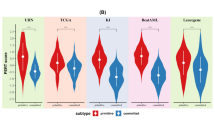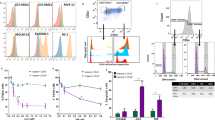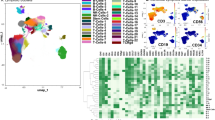Abstract
Relapse in acute myeloid leukaemia (AML) is considered to result from the persistence of drug-resistant leukaemic stem and progenitor cells (LSPC) within a bone marrow ‘niche’ microenvironment. Identifying novel agents that have the potential to target these LSPC in their niche microenvironment will aid in the characterization of candidate agents for post-remission chemotherapy. Using an in vitro model, we found that 48-h culture with gemtuzumab ozogamicin (Mylotarg) resulted in a 34% reduction in CD34+CD38−CD123+ LSPC number, whereas normal CD34+CD38− haemapoietic stem cells were insensitive to this agent. As there was considerable heterogeneity in LSPC response to Mylotarg treatment, various factors potentially underpinning the differential response were assessed. LSPC that overexpressed CD33 (P=0.01), which were P-glycoprotein-negative (P=0.008) and with internal tandem duplication (ITD) of the FLT3 gene (FLT3/ITD) status (P=0.006) responded better to Mylotarg treatment. LSPC from patient samples that have these combined characteristics as well as low LSPC burden showed significantly more chemosensitivity to Mylotarg compared with all other cases (P=0.002). In multivariate analysis, LSPC burden and FLT3 status were found to be predictors of LSPC chemosensitivity to Mylotarg treatment (P<0.0001). In conclusion, we have shown heterogeneity in the LSPC compartment of AML patients underpinning differential in vitro sensitivity to Mylotarg.
This is a preview of subscription content, access via your institution
Access options
Subscribe to this journal
Receive 12 print issues and online access
$259.00 per year
only $21.58 per issue
Buy this article
- Purchase on Springer Link
- Instant access to full article PDF
Prices may be subject to local taxes which are calculated during checkout





Similar content being viewed by others
References
Jordan CT, Upchurch D, Szilvassy SJ, Guzman ML, Howard DS, Pettigrew AL et al. The interleukin-3 receptor alpha chain is a unique marker for human acute myelogenous leukemia stem cells. Leukemia 2000; 14: 1777–1784.
Florian S, Sonneck K, Hauswirth AW, Krauth MT, Schernthaner GH, Sperr WR et al. Detection of molecular targets on the surface of CD34+/CD38− stem cells in various myeloid malignancies. Leuk Lymphoma 2006; 47: 207–222.
Hauswirth AW, Florian S, Printz D, Sotlar K, Krauth MT, Fritsch G et al. Expression of the target receptor CD33 in CD34+/CD38−/CD123+ AML stem cells. Eur J Clin Invest 2007; 37: 73–82.
van Rhenen A, Moshaver B, Kelder A, Feller N, Nieuwint AW, Zweegman S et al. Aberrant marker expression patterns on the CD34+CD38− stem cell compartment in acute myeloid leukemia allows to distinguish the malignant from the normal stem cell compartment both at diagnosis and in remission. Leukemia 2007; 2: 1700–1707.
Mony U, Jawad M, Seedhouse C, Russell N, Pallis M . Resistance to FLT3 inhibition in an in vitro model of primary AML cells with a stem cell phenotype in a defined microenvironment. Leukemia 2008; 22: 1395–1401.
Stasi R, Evangelista ML, Buccisano F, Venditti A, Amadori S . Gemtuzumab ozogamicin in the treatment of acute myeloid leukemia. Cancer Treat Rev 2008; 34: 49–60.
Dinndorf PA, Andrews RG, Benjamin D, Ridgway D, Wolff L, Bernstein ID . Expression of normal myeloid-associated antigens by acute leukemia cells. Blood 1986; 67: 1048–1053.
Griffin JD, Linch D, Sabbath K, Larcom P, Schlossman SF . A monoclonal antibody reactive with normal and leukemic human myeloid progenitor cells. Leuk Res 1984; 8: 521–534.
Taussig DC, Pearce DJ, Simpson C, Rohatiner AZ, Lister TA, Kelly G et al. Hematopoietic stem cells express multiple myeloid markers: implications for the origin and targeted therapy of acute myeloid leukemia. Blood 2005; 106: 4086–4092.
Linenberger ML, Hong T, Flowers D, Sievers EL, Gooley TA, Bennett JM et al. Multidrug-resistance phenotype and clinical responses to gemtuzumab ozogamicin. Blood 2001; 98: 988–994.
Zein N, Sinha AM, McGahren WJ, Ellestad GA . Calicheamicin gamma 1I: an antitumor antibiotic that cleaves double-stranded DNA site specifically. Science 1988; 240: 1198–1201.
Burnett AK, Kell WJ, Goldstone AH, Milligan D, Hunter A, Prentice AG et al. The addition of gemtuzumab ozogamicin to induction chemotherapy for AML improves disease free survival without extra toxicity: preliminary analysis of 1115 patients in the MRC AML15 trial. Blood 2006; 108 (Abstracts, 13).
Walter RB, Gooley TA, van der Velden VH, Loken MR, van Dongen JJ, Flowers DA et al. CD33 expression and P-glycoprotein-mediated drug efflux inversely correlate and predict clinical outcome in patients with acute myeloid leukemia treated with gemtuzumab ozogamicin monotherapy. Blood 2007; 109: 4168–4170.
Pallis M, Syan J, Russell NH . Flow cytometric chemosensitivity analysis of blasts from patients with acute myeloblastic leukemia and myelodysplastic syndromes: the use of 7AAD with antibodies to CD45 or CD34. Cytometry 1999; 37: 308–313.
Pallis M, Das-Gupta E . Flow cytometric measurement of functional and phenotypic P-glycoprotein. Meth Mol Med 2005; 111: 167–181.
Seedhouse CH, Hunter HM, Lloyd-Lewis B, Massip AM, Pallis M, Carter GI et al. DNA repair contributes to the drug-resistant phenotype of primary acute myeloid leukaemia cells with FLT3 internal tandem duplications and is reversed by the FLT3 inhibitor PKC412. Leukemia 2006; 20: 2130–2136.
Kottaridis PD, Gale RE, Frew ME, Harrison G, Langabeer SE, Belton AA et al. The presence of a FLT3 internal tandem duplication in patients with acute myeloid leukemia (AML) adds important prognostic information to cytogenetic risk group and response to the first cycle of chemotherapy: analysis of 854 patients from the United Kingdom Medical Research Council AML 10 and 12 trials. Blood 2001; 98: 1752–1759.
Gilliland DG, Griffin JD . The roles of FLT3 in hematopoiesis and leukemia. Blood 2002; 100: 1532–1542.
Nakao M, Yokota S, Iwai T, Kaneko H, Horiike S, Kashima K et al. Internal tandem duplication of the flt3 gene found in acute myeloid leukaemia. Leukemia 1996; 10: 1911–1918.
Levis M, Murphy KM, Pham R, Kim KT, Stine A, Li L et al. Internal tandem duplications of the FLT3 gene are present in leukemia stem cells. Blood 2005; 106: 673–680.
Costello RT, Mallet F, Gaugler B, Sainty D, Arnoulet C, Gastaut JA et al. Human acute myeloid leukemia CD34+/CD38− progenitor cells have decreased sensitivity to chemotherapy and Fas-induced apoptosis, reduced immunogenicity, and impaired dendritic cell transformation capacities. Cancer Res 2000; 60: 4403–4411.
Guzman ML, Rossi RM, Neelakantan S, Li X, Corbett CA, Hassane DC et al. An orally bioavailable parthenolide analog selectively eradicates acute myelogenous leukemia stem and progenitor cells. Blood 2007; 110: 4427–4435.
Walter RB, Raden BW, Hong TC, Flowers DA, Bernstein ID, Linenberger ML . Multidrug resistance protein attenuates gemtuzumab ozogamicin-induced cytotoxicity in acute myeloid leukemia cells. Blood 2003; 102: 1466–1473.
Morris KL, Adams JA, Liu JA . Effect of Gemtuzumab Ozogamicin on acute myeloid leukemia blast cells in vitro, as a single agent and combined with other cytotoxic cells. Br J Haematol 2006; 135: 509–512.
Pallis M, Turzanski J, Higashi Y, Russell N . P-glycoprotein in acute myeloid leukaemia: therapeutic implications of its association with both a multidrug-resistant and an apoptosis-resistant phenotype. Leuk Lymphoma 2002; 43: 1221–1228.
van Rhenen A, Feller N, Kelder A, Westra AH, Rombouts E, Zweegman S et al. High stem cell frequency in acute myeloid leukemia at diagnosis predicts high minimal residual disease and poor survival. Clin Cancer Res 2005; 11: 6520–6527.
Walter RB, Raden BW, Kamikura DM, Cooper JA, Bernstein ID . Influence of CD33 expression levels and ITIM-dependent internalization on gemtuzumab ozogamicin-induced cytotoxicity. Blood 2005; 105: 1295–1302.
Jedema I, Barge RM, van der Velden VH, Nijmeijer BA, van Dongen JJ, Willemze R et al. Internalization and cell cycle-dependent killing of leukemic cells by gemtuzumab ozogamicin: rationale for efficacy in CD33-negative malignancies with endocytic capacity. Leukemia 2004; 18: 316–325.
Sievers EL, Larson RA, Stadtmauer EA, Estey E, Löwenberg B, Dombret H et al. Efficacy and safety of gemtuzumab ozogamicin in patients with CD33-positive acute myeloid leukemia in first relapse. J Clin Oncol 2001; 19: 3244–3254.
van Der Velden VH, te Marvelde JG, Hoogeveen PG, Bernstein ID, Houtsmuller AB, Berger MS et al. Targeting of the CD33-calicheamicin immunoconjugate Mylotarg (CMA-676) in acute myeloid leukemia: in vivo and in vitro saturation and internalization by leukemic and normal myeloid cells. Blood 2001; 97: 3197–3204.
van Stijn A, Kok A, van Stalborch MA, van Der Pol MA, Feller N, Westra AH et al. Minimal residual disease cells in AML patients have an apoptosis-sensitive protein profile. Leukemia 2004; 18: 875–877.
Leone G, Rutella S, Voso MT, Fianchi L, Scardocci A, Pagano L . In vivo priming with granulocyte colony-stimulating factor possibly enhances the effect of gemtuzumab-ozogamicin in acute myeloid leukemia: results of a pilot study. Haematologica 2004; 89: 634–636.
Rutella S, Bonanno G, Procoli A, Mariotti A, Lucia MB, Contemi AM et al. Granulocyte colony-stimulating factor enhances the in vitro cytotoxicity of gemtuzumab ozogamicin against acute myeloid leukemia cell lines and primary blast cells. Exp Hematol 2006; 34: 54–65.
Balaian L, Ball ED . Cytotoxic activity of gemtuzumab ozogamicin (Mylotarg) in acute myeloid leukemia correlates with the expression of protein kinase Syk. Leukemia 2006; 20: 2093–2101.
Jawad M, Russell N, Pallis M . Azacytidine and gemtuzumab ozogamicin co-operate to inhibit the Wnt pathway and increase cytotoxicity in AML. Blood 2008 (ASH Abstract, 2991).
Acknowledgements
This study was funded by a project grant from the Leukaemia Research Fund. We thank the NCRN AML Working Group for permission to use trial samples.
Author information
Authors and Affiliations
Corresponding author
Additional information
Supplementary Information accompanies the paper on the Leukemia website (http://www.nature.com/leu)
Supplementary information
Rights and permissions
About this article
Cite this article
Jawad, M., Seedhouse, C., Mony, U. et al. Analysis of factors that affect in vitro chemosensitivity of leukaemic stem and progenitor cells to gemtuzumab ozogamicin (Mylotarg) in acute myeloid leukaemia. Leukemia 24, 74–80 (2010). https://doi.org/10.1038/leu.2009.199
Received:
Revised:
Accepted:
Published:
Issue Date:
DOI: https://doi.org/10.1038/leu.2009.199
Keywords
This article is cited by
-
Impact of gemtuzumab ozogamicin consolidation on hematopoietic stem cells (HSCs) mobilization in AML: analysis of 20 patients
Annals of Hematology (2023)
-
CAR-T Cell Therapy for Acute Myeloid Leukemia: Preclinical Rationale, Current Clinical Progress, and Barriers to Success
BioDrugs (2021)
-
An mTORC1/2 dual inhibitor, AZD2014, acts as a lysosomal function activator and enhances gemtuzumab ozogamicin-induced apoptosis in primary human leukemia cells
International Journal of Hematology (2019)
-
Expression of CD33 is a predictive factor for effect of gemtuzumab ozogamicin at different doses in adult acute myeloid leukaemia
Leukemia (2017)
-
Leukemic stem cells: identification and clinical application
International Journal of Hematology (2017)



